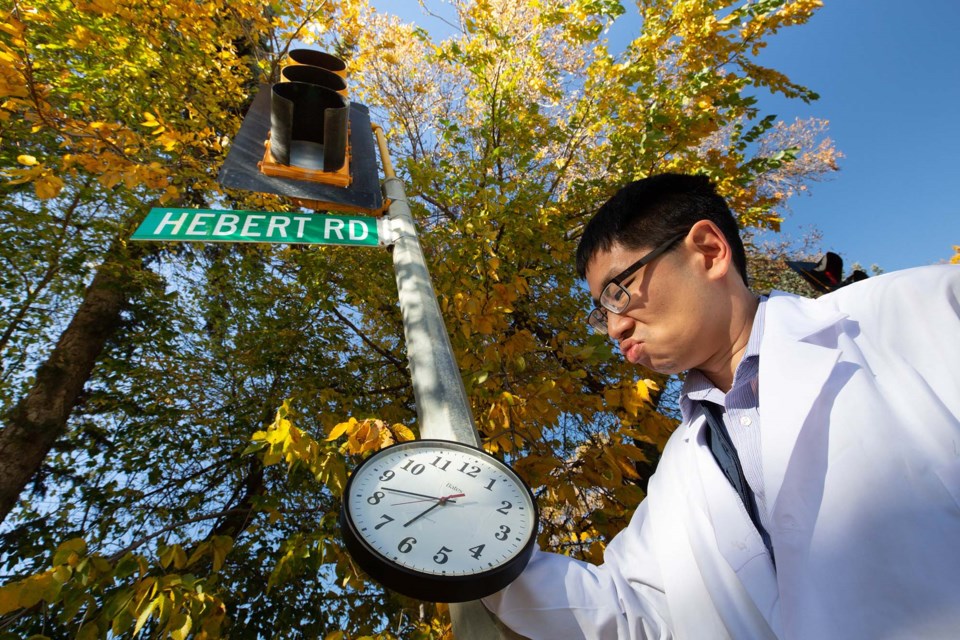What is St. Albert’s longest red light?
The Gazette’s Readers’ Choice poll says it is the one at Arlington Drive and Hebert Road, but the evidence suggests otherwise.
City transportation manager Dean Schick says that particular light is the same length (diameter) as almost all the new traffic signals in town at about 30 cm (12 inches) – there are still a few old 20 cm ones around.
St. Albert's red lights are also all roughly the same shade of red, suggesting their wavelength is between 620 and 720 nanometres (likely 650, as they are a bright red, suggests Telus World of Science space science manager Frank Florian).
St. Albert transportation systems supervisor Marius Vlad says the average red light at Arlington and Hebert lasts 65 seconds, which is well below the 74-second average on St. Albert Trail (which has the longest signal cycles in the city).
So what is the real longest red light in St. Albert? The Gazette turns to science for the answer.
Red science
The Gazette spoke to Schick and Vlad in the traffic light control centre at St. Albert Place, which contains a computer, four wide-screen displays on the wall, a pastel-patterned traffic light control box, and Vlad.
The city uses a combination of traffic counts and analytics to set light patterns, Schick explains.
“Our signal timing is intended to accommodate everyone,” he says – both rush-hour drivers and little old grannies crossing St. Albert Trail.
The system prioritizes volume, he continues – if one half of an intersection (e.g. Hebert) sees more cars than the other (Arlington), it will get a bigger share of the green light time to ensure traffic flow.
Cities use different technologies to cause signals to change, Schick says. Some set their lights on timed cycles, while others use inductive loops in the ground to detect cars.
St. Albert’s signals are detection-based, the detectors in this case being video cameras.
Assume you are approaching the red light at Arlington, Schick says. When you arrive, the camera detects you and triggers a signal cycle. If the cameras spot heavy traffic on Hebert when you arrive, that cycle will give most of the green time to Hebert, which means a long red for you. If an ambulance is blasting down Hebert to an emergency, a transmitter on it will override the cycle to keep Hebert green, which means an even longer red.
How long is long?
Vlad and Schick say the longest red light in St. Albert is on St. Albert Trail at the Superstore turnoff, which can last up to 97 seconds between 3 p.m. and 7 p.m. A well-timed ambulance could theoretically boost this to 145 seconds.
Vlad and Schick say a traffic light on a street that never saw cars or pedestrians and never had mechanical problems could theoretically stay red for about 15 years (the estimated lifetime of a modern traffic signal) – but you probably wouldn’t bother with a light there.
If you want the longest red light visible from St. Albert, you will have to look up and find a red dwarf star, Florian said. These stars have been around for billions of years and will stay red for trillions more. If you are waiting for one of these to turn green, you might be out of luck.
Turn green, darn it!
So how can you make that red light turn green faster?
Don't ask Vlad. He may be able to turn any signal in town green with a push of a button, but he says he will not do so for fear of causing traffic chaos.
You can try pushing the crosswalk button, as doing so will start a signal cycle in the event the traffic camera is broken, Schick said. That is probably a bad idea unless you're a pedestrian though, as jumping out of a running car is not safe.
You can try using the Doppler effect, Florian says. The Doppler effect causes light waves from objects approaching us to compress, which changes their colour. Approach a traffic signal with enough speed, and you can turn that long-wave red light into shorter-wave green.
“You’d have to go really, really fast,” Florian says – about 55,000 km/sec, assuming a bright-red signal of 650 nanometres, which is roughly 16 per cent of the speed of light.
“You’d probably end up with one big speeding ticket if (the cops) could catch you.”
You would also need a lot of heat shielding, says University of Alberta physicist Roger Moore. At those speeds, the typical unshielded 2,000kg car will instantly vapourize from the heat caused by air resistance, releasing a bright flash and an explosion equivalent to the detonation of 0.6 kilotons of TNT.
“The result is that you would not really live long enough to notice how long the light was and indeed the red light itself would almost certainly be cut short by the blast wave,” Moore says.
You can also just relax. Human perception of time is influenced by attention and emotion, says U of A psychology professor Karsten Loepelmann – the more you focus on the passage of time, or the angrier you feel, the slower time seems to move. If you don’t focus on the time, pay attention to something else (such as the radio) and take a few deep breaths, the light will not seem to take as long.
Or you can wait for the city to adjust the signal timing. The city monitors traffic signal performance on Vlad’s computer and constantly tweaks their timings, Schick says. It has also been testing adaptive signals technology along Boudreau since 2019, which uses intersection-based computers to adjust timings automatically.
If a light seems unusually long – say, 3.5 minutes – or is changing on a fixed cycle, Schick said the signal might be broken. Call Engineering Services at 780-459-1654 so they can send a team to fix it.




